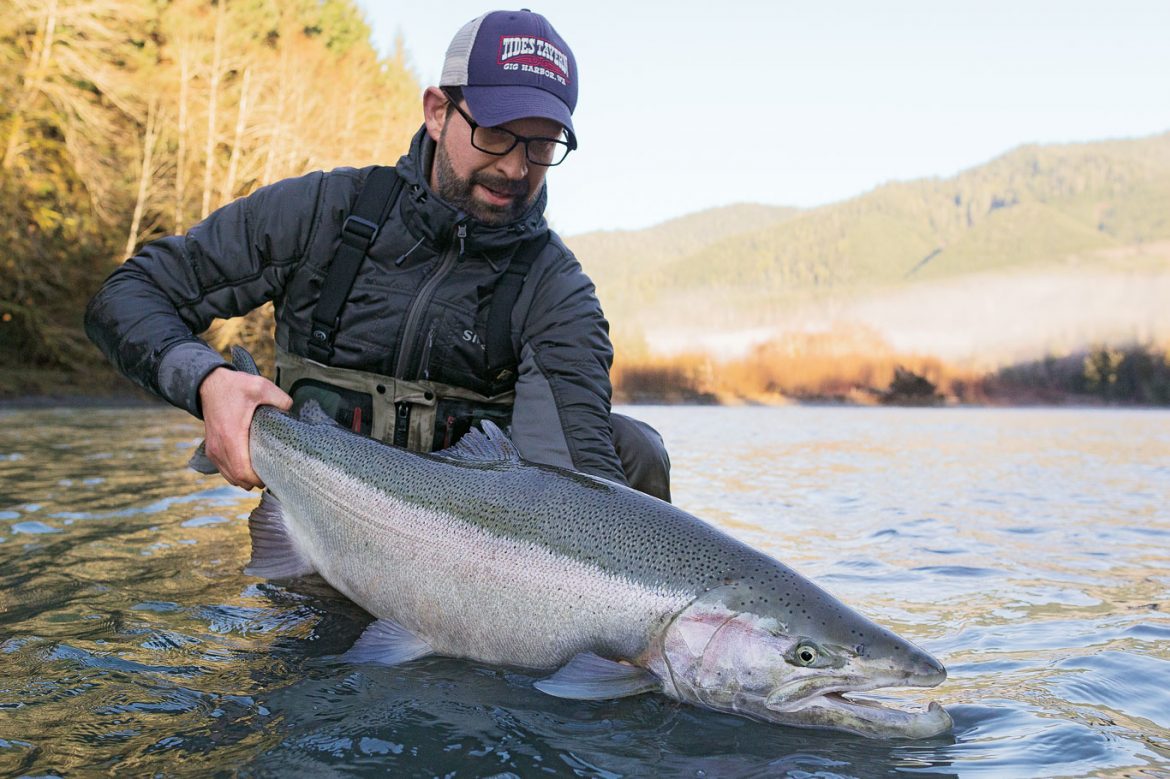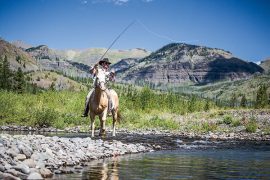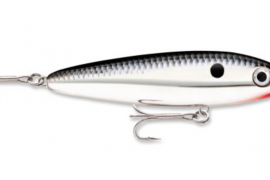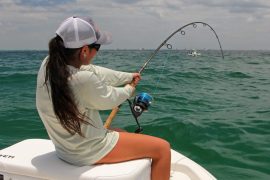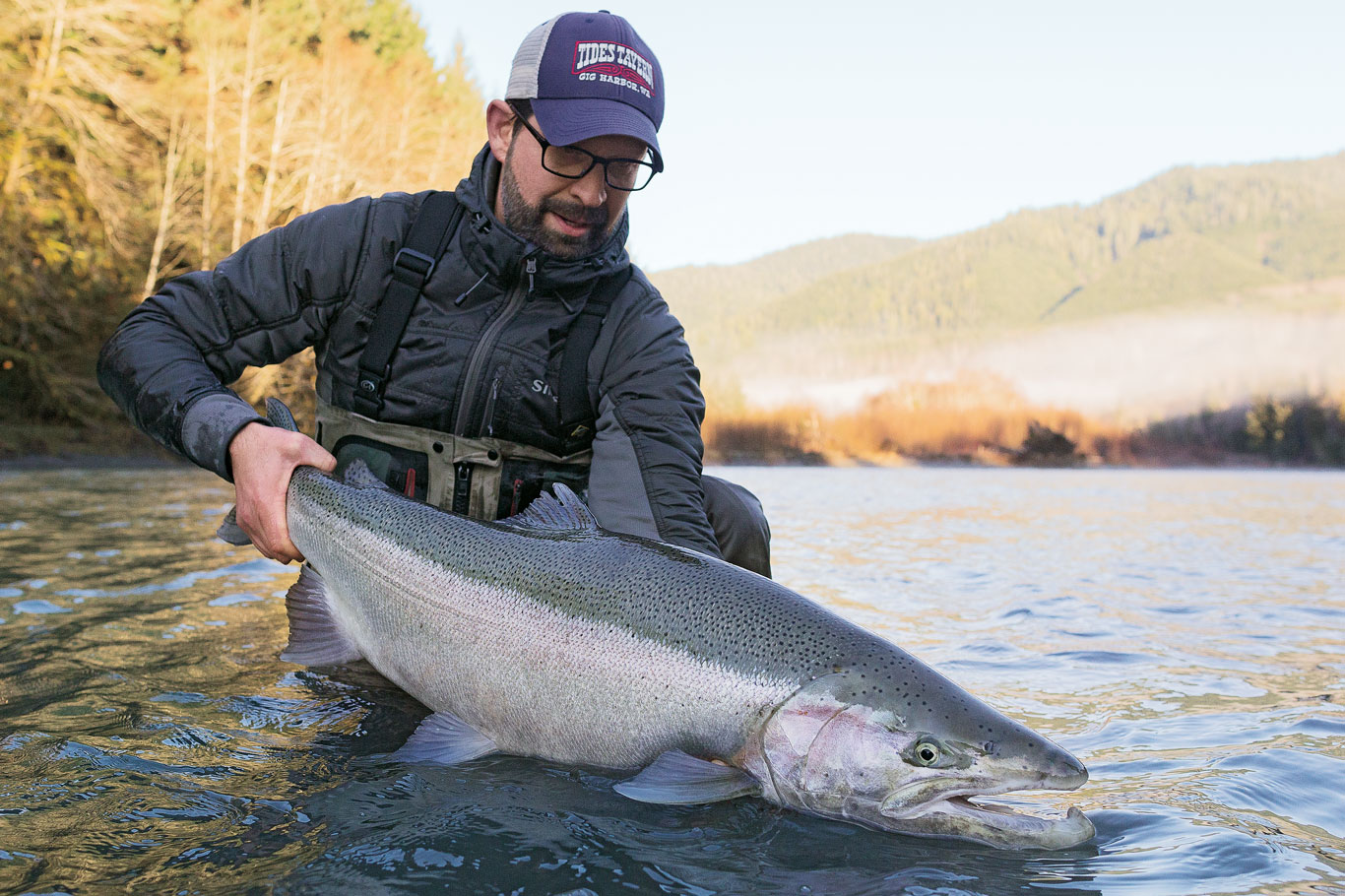
One of my favorite parts of guiding steelhead anglers has always been watching the glowing line swing across the blue and green currents. Fly fishers waist deep in the river rarely have a clear view of the swing, which is a shame because there’s profound pleasure in watching a fly swim through fishy water. More to the point, when you’re waist deep, you don’t see how a fish acted before it ate or what precisely about your swing prompted the fish to chase in the first place.
Over the years, I’ve had the pleasure of watching—from an elevated vantage point—a few hundred steelhead chase and eat a fly. Those experiences have taught me a lot about how to position my own casts so as to tempt steelhead into taking, and taking well. What follows is the story of three fish and the lessons those fish revealed to me about effectively presenting flies to steelhead.
Prompting the Territorial Grab:
The Slow Swing
In March I was fishing an under-the-radar coastal stream where a healthy run of big, wild steelhead returns each winter. My client, Jason, had been here with me before, and knew how to fish the run. The day was unseasonably warm, with a gentle breeze blowing upstream, and the afternoon sun was turning the river to electric green. We had to make a steep descent to get to the place, following elk trails through the salmonberry and ferns, but once there we both looked at each other and just knew a fish was about to be caught.

This run is a short one immediately above and below two plunge pools where the currents work to slow steelhead on their upstream migration. The river moves quickest along the river-right bank, over basalt ledges. About midstream, the ledges end and gravel begins. Jason stepped into the head of the run and began stripping out line at once, while I moved partway downstream to watch from the high bank.
Jason fished the run as he had before, casting quartering across to the fast bank, mending once to slow the swing, and then led the line with the rod tip to help the swing cover the whole pool and eventually reach the shallows on the left bank. It all looked very fishy, and I was certain he was going to get grabbed.
About halfway through the pool, Jason reached the bucket, and we both braced for a grab. As the fly swam through the lie, the line tightened but then went slack. I asked if it was a steelhead, and Jason shook his head. “No, just a trout . . . I think. But I’ll cast a couple more times just to be sure.”
Three more casts did not tempt whatever had plucked at the fly the first time. So I joined Jason in the water with a smaller fly in the same color. Yet, a half dozen swings with that pattern didn’t work either. So Jason moved on down the run. When he reeled in, he still hadn’t hooked a fish. It was nearly time to call it a day, but neither of us was ready to give up just yet.
“Let’s try the middle of the run one more time,” I said, and handed Jason a fly with a little more weight. “This time, make the longest cast you can, and then throw four big mends in the first moments of the swing. Slow the fly way down.”
This time, as Jason approached the bucket, he was holding his rod high and out over the water, and the fly was swinging across the current as slowly as it possibly could. The fly wasn’t very deep; I could see it down about 2 feet in 5 feet of water. And then it disappeared in a swirl of rose and silver.
The great buck rolled at once, and then charged upstream and under the fast water. When that didn’t work, he turned and bolted to the bottom of the pool, and Jason’s old reel lit up the canyon with a roar.
The buck Jason finally landed had been in this pool for a few days; the water was low, and the steelhead weren’t doing a lot of moving around. This was a fish that wasn’t aggressive or curious, he was simply holding here until the rains returned and he could continue toward his preferred tributary. He was within a month or two of spawning, and by slowing the fly way down, I believe Jason was able to awaken the fish’s territorial impulses.
I put that theory to the test over the next week of guiding. Each day, my clients fished each run in the traditional manner, and then we went back through the best bucket with an extra-slow swing. Of the fish we caught that week, only one ate a traditional presentation. The others were all bucks, and ate on the second pass after we slowed the fly way, way down. In the years since, I’ve made this variation a staple of my…

